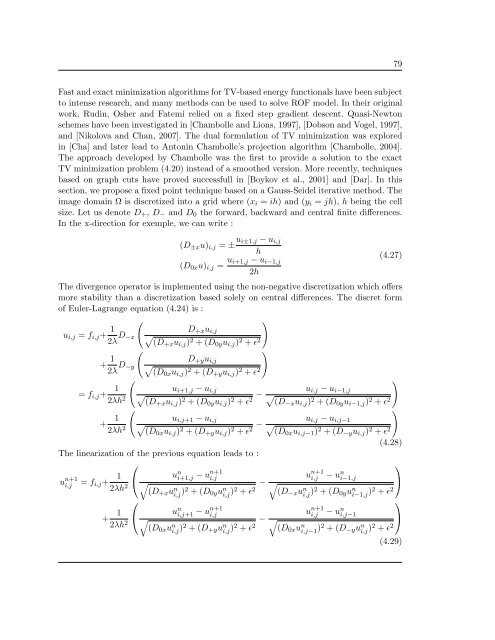Th`ese Marouan BOUALI - Sites personnels de TELECOM ParisTech
Th`ese Marouan BOUALI - Sites personnels de TELECOM ParisTech
Th`ese Marouan BOUALI - Sites personnels de TELECOM ParisTech
Create successful ePaper yourself
Turn your PDF publications into a flip-book with our unique Google optimized e-Paper software.
79<br />
Fast and exact minimization algorithms for TV-based energy functionals have been subject<br />
to intense research, and many methods can be used to solve ROF mo<strong>de</strong>l. In their original<br />
work, Rudin, Osher and Fatemi relied on a fixed step gradient <strong>de</strong>scent. Quasi-Newton<br />
schemes have been investigated in [Chambolle and Lions, 1997], [Dobson and Vogel, 1997],<br />
and [Nikolova and Chan, 2007]. The dual formulation of TV minimization was explored<br />
in [Cha] and later lead to Antonin Chambolle’s projection algorithm [Chambolle, 2004].<br />
The approach <strong>de</strong>veloped by Chambolle was the first to provi<strong>de</strong> a solution to the exact<br />
TV minimization problem (4.20) instead of a smoothed version. More recently, techniques<br />
based on graph cuts have proved successfull in [Boykov et al., 2001] and [Dar]. In this<br />
section, we propose a fixed point technique based on a Gauss-Sei<strong>de</strong>l iterative method. The<br />
image domain Ω is discretized into a grid where (x i = ih) and (y i = jh), h being the cell<br />
size. Let us <strong>de</strong>note D + , D − and D 0 the forward, backward and central finite differences.<br />
In the x-direction for exemple, we can write :<br />
(D ±x u) i,j = ± u i±1,j − u i,j<br />
h<br />
(D 0x u) i,j = u i+1,j − u i−1,j<br />
2h<br />
(4.27)<br />
The divergence operator is implemented using the non-negative discretization which offers<br />
more stability than a discretization based solely on central differences. The discret form<br />
of Euler-Lagrange equation (4.24) is :<br />
u i,j = f i,j + 1<br />
2λ D −x<br />
+ 1<br />
2λ D −y<br />
(<br />
(<br />
)<br />
D +x u i,j<br />
√<br />
(D+x u i,j ) 2 +(D 0y u i,j ) 2 + ɛ 2<br />
)<br />
D +y u i,j<br />
√<br />
(D0x u i,j ) 2 +(D +y u i,j ) 2 + ɛ 2<br />
(<br />
)<br />
= f i,j + 1<br />
u i+1,j − u i,j<br />
2λh 2 √<br />
(D+x u i,j ) 2 +(D 0y u i,j ) 2 + ɛ − u i,j − u i−1,j<br />
√ 2 (D−x u i,j ) 2 +(D 0y u i−1,j ) 2 + ɛ 2<br />
(<br />
)<br />
+ 1<br />
u i,j+1 − u i,j<br />
2λh 2 √<br />
(D0x u i,j ) 2 +(D +y u i,j ) 2 + ɛ − u i,j − u i,j−1<br />
√ 2 (D0x u i,j−1 ) 2 +(D −y u i,j ) 2 + ɛ 2<br />
(4.28)<br />
The linearization of the previous equation leads to :<br />
⎛<br />
⎞<br />
u n+1<br />
i,j<br />
= f i,j + 1<br />
u<br />
⎝<br />
n i+1,j − un+1 i,j<br />
u n+1<br />
i,j<br />
− u n i−1,j<br />
2λh 2 − √<br />
⎠<br />
√(D +x u n i,j )2 +(D 0y u n i,j )2 + ɛ 2 (D −x u n i,j )2 +(D 0y u n i−1,j )2 + ɛ 2<br />
⎛<br />
⎞<br />
+ 1<br />
u<br />
⎝<br />
n i,j+1 − un+1 i,j<br />
u n+1<br />
i,j<br />
− u n i,j−1<br />
2λh 2 − √<br />
⎠<br />
√(D 0x u n i,j )2 +(D +y u n i,j )2 + ɛ 2 (D 0x u n i,j−1 )2 +(D −y u n i,j )2 + ɛ 2<br />
(4.29)















